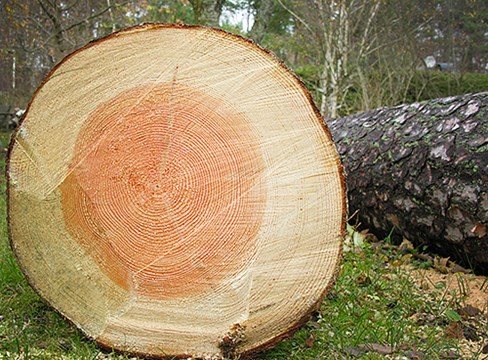Wood protection
Structural wood protection
Wood protection usually refers to measures that in various ways aim to protect wood and wood-based materials against attacks by destructive organisms. These include wood-decaying fungi, insects, marine pests such as shipworm and discolouring microorganisms such as blue stain and mould.
Wood-decaying fungus is the most common of the destructive organisms in Sweden, and when building in wood the structure and its assembly should be designed to prevent rot as far as possible. The main aim is to avoid moisture traps that expose the wood to excessive moisture levels for a prolonged period. Temporary damp should be able to dry out quickly and the moisture content should be able to return to normal levels quickly. Good structural wood protection options for most details involved in wood construction can be found at www.traguiden.se.
Treated wood products
There are situations where it is difficult, or even impossible, to design the structure so that the wood is not permanently exposed to high moisture levels. In these cases, wood with good enough natural durability for the purpose, or wood material treated with various substances, can extend the service life. Pressure-treated timber has been around for a long time and in the modern age uses various types of copper salts. Other treated wood products available today include modified wood treated with acetic anhydride, furfuryl alcohol and heat.
As well as methods to improve wood’s durability, there are also methods to improve the fireproofing, hardness and dimensional stability of wood and wood-based materials.
Guidance in choosing wood protection
Wood protection is an important consideration when building anything in wood. The interplay between structural design, material choices and maintenance plays a crucial role in the structure’s function and service life. As outlined above, when it comes to designing structures, the first point is, as far as possible, to avoid moisture traps where the wood is unable to easily dry out, creating a risk factor for future rot to set in.
Considering the ever-increasing range of materials available, answering the following questions will make it easier to choose a material and prescribe appropriate wood protection:
- What are the requirements or wishes concerning the structure’s expected service life?
- Is the structure exposed to wind and weather, is it close to or in contact with the ground or water, is it impossible to avoid moisture traps?
- Is the structure easy to inspect for any damage?
- What consequences could an unexpected failure have, and is there a risk of personal injury?
- Are there any specific requirements or wishes concerning technical properties or interaction with other materials? Is the structure load-bearing? What is the situation regarding colour fastness? Can the wood be painted?
- What maintenance can be expected during the wood’s lifetime and is the structure easy to access for maintenance and repairs?
- How is waste handled (offcuts, scrap wood)? Could it be used to fire your own boiler, for example, or does it have to be taken to the local waste facility?
The expected service life, or technical lifetime, is important, and here aesthetic considerations must also be taken into account. The higher the standards required, the more important it is to take account of both the structural design and the material’s properties from a durability perspective and in terms of maintenance and aesthetics.
When assessing the risk of attack from wood-destroying organisms, there is always a risk to wooden structures in permanent contact with the ground and saltwater or freshwater. For structures above ground, there is a risk of rot that can be graded from almost negligible to essentially as great as in contact with the ground, and it is not always easy to calculate the risk.
Pressure-treated wood
Pressure-treated wood is the most common wood material with improved durability on the market. It is manufactured in industrial processes, preferably using pine. Only the sapwood can be impregnated all the way through, while the heartwood cannot be impregnated. Wood preservative will therefore only superficially penetrate heartwood that is exposed on the surface of a board or plank.
Spruce is also processed at industrial pressure-treatment plants, but the penetration of wood preservative in spruce will only ever be superficial. Lower protection against destructive organisms will thus be achieved compared with pine. There is limited availability of preservative-treated spruce on the market, and the majority of the production volume is exported.
A classification for pressure-treated wood sold in the Nordic countries has been drawn up by the Nordic Wood Preservation Council (NTR), based on European standards for treated wood. The purpose of the classification is to help the user to choose the right kind of wood protection for the application in question. The classification applies to both pine and spruce industrially treated with wood preservative. See table 14.
The majority of treated wood sold on the Nordic market is quality controlled and NTR labelled. The checks are carried out by an independent inspection body, and the controls are certified by a third party. They relate to the quality of the finished product and its compliance with the specified requirements for the relevant wood preservation classes concerning penetration and absorption of wood preservative in the sapwood. Treated wood that is not quality controlled to NTR standards, usually imported, can also be found on the market.
Pressure-treated wood is usually produced to meet wood preservation class NTR AB for use in structures above ground, such as decking and other wood, outdoors in private and public environments. Around a third of production is treated to wood preservation class NTR A for use in contact with the ground or freshwater. Production in other wood preservation classes is marginal since, for obvious reasons, there is less demand.
To facilitate the handling of pressure-treated wood at the retail stage and during construction, products in the wood preservation classes NTR AB and NTR A are also supplied in different dimensions. Products with slimmer dimensions up to a thickness of 38 mm and those that are 45 mm thick and 125 mm wide are used mainly above ground, and are produced to comply with NTR AB. Larger dimensions are used in contact with the ground or freshwater or in critical structures, where NTR A is needed. See table 15.
Treated wood products that are classified using NTR’s wood preservation classes and sold in builders’ merchants are treated with water-based wood preservative containing copper as the active ingredient. It is the copper that gives the wood its characteristic green colour. Brown treated wood products, mainly for decking, are also available. The brown colour will not last a long time, so this product has to be regularly oiled with a pigmented wood oil in order to maintain its appearance.
Table 14 Treated wood – preservation classes, applications, labelling and penetration
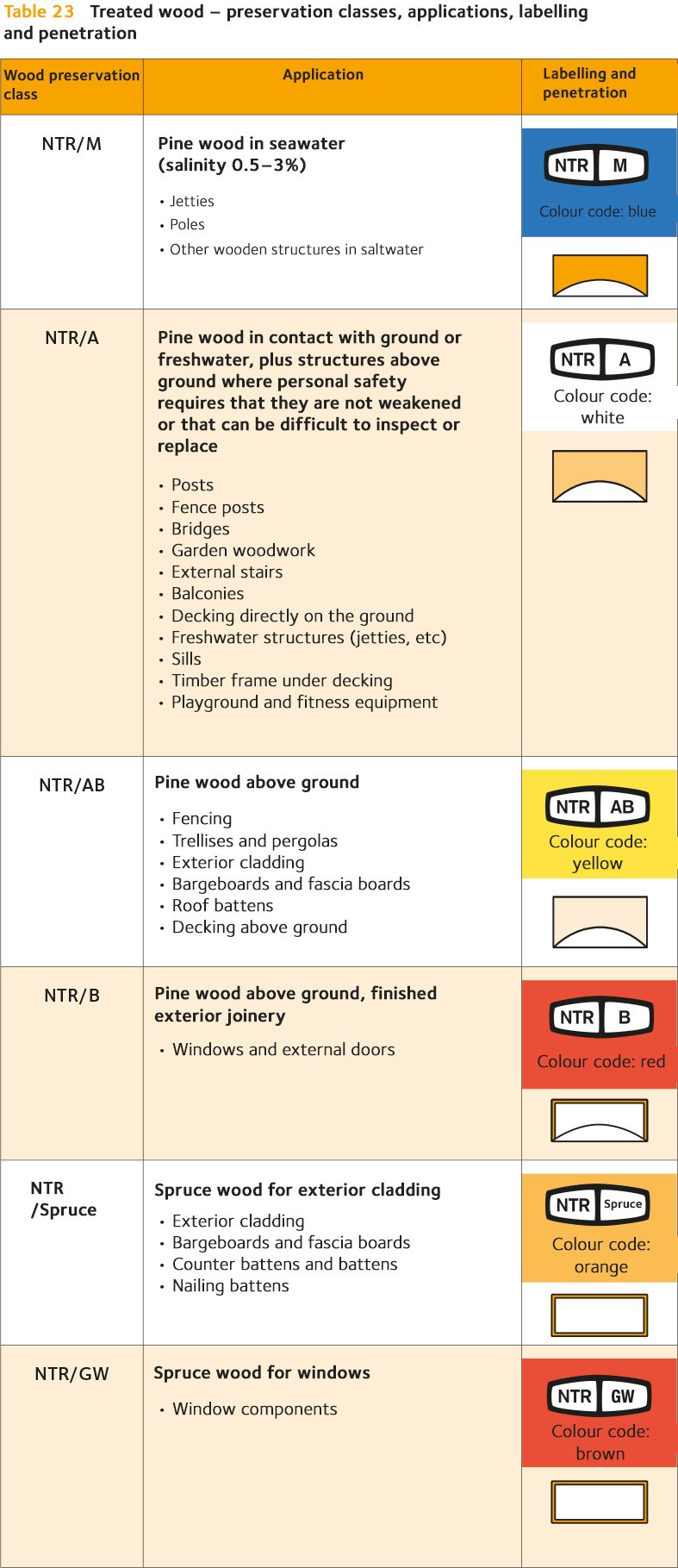
Treated wood coloured with a lasting pigment is produced using a special multistep technique. The first step is treatment with a water-based wood preservative. In the second step, the wood is placed in a vacuum and boiled in a pigmented linseed oil that penetrates into the surface of the wood, while at the same time the water added in the first step is cooked off. By the end of the treatment, the wood is construction dry and ready for use. The linseed oil, which can also be unpigmented, gives the wood a water-repellent surface that minimises moisture-related movement and splitting.
The technical properties of the treated wood, such as strength and moisture absorption, are largely the same as for untreated wood. However, the effect on metals is different. Since treated wood is used in structures that are exposed to moisture, stainless steel, hot dip galvanised steel or a material with equivalent corrosion resistance is recommended for fasteners and fixings.
Processing of treated wood should be avoided, but where this is unavoidable, processed surfaces should then be treated with penetrating priming oil or a wood preservative designed for surface treatment.
The environmental profile of treated wood is sometimes called into question. However, wood preservatives are covered by stringent legislation under the EU’s Biocidal Products Regulation (BPR), which sets extremely tough demands for exhaustive documentation of environmental and health effects.
The environmental impact of pressure-treated wood has been documented in multiple studies by independent institutions in Sweden and abroad. 2018 saw the publication of results from a comparative life cycle assessment (LCA) conducted by the Danish Technological Institute and the IVL Swedish Environmental Research Institute. The comparison examined the climate impact of various materials, including pressure-treated wood in class NTR AB, Siberian larch and a wood-plastic composite, for the construction of a 30 m2 terrace with an expected service life of 30 years, expressed in terms of a carbon footprint. Wood generally came out better in the comparison, with pressure-treated wood doing best of all.
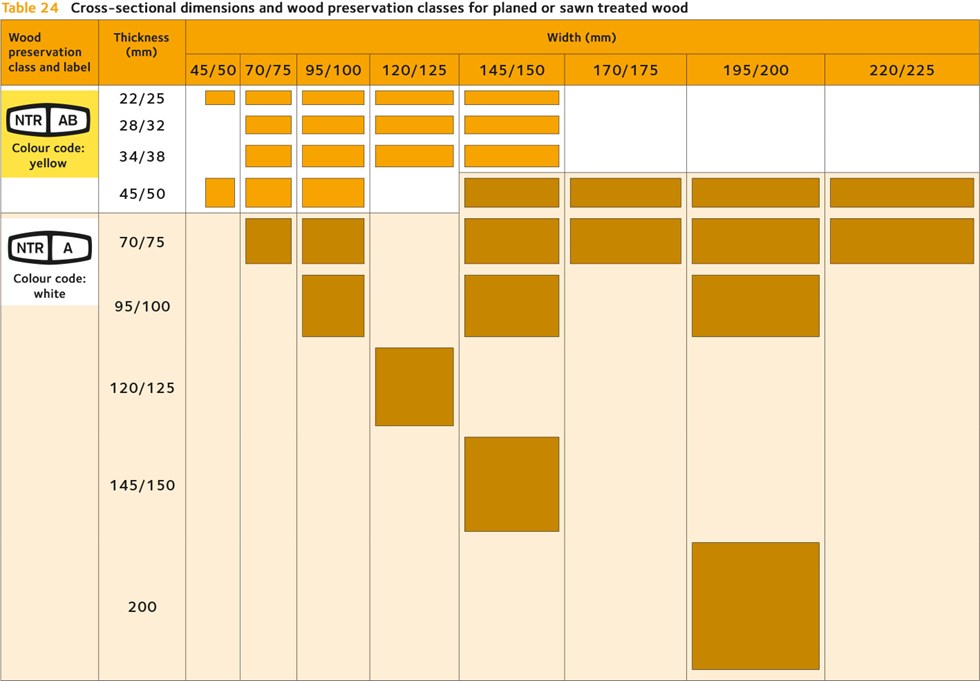
Modified wood
The durability properties of wood can also be improved through modification. This involves treating the wood chemically, although not with biocidal agents, or physically, to achieve greater resistance to wood-destroying organisms. The modification of wood is an industrial process and there are currently three different variants on the market: acetylated wood, which is impregnated with acetic anhydride; furfurylated wood, which is impregnated with furfuryl alcohol; and heat-treated wood (Thermally Modified Timber – TMT), which is produced by heating the wood to 160–215°C in an oxygen-free atmosphere.
The Nordic Wood Preservation Council (NTR) has developed a classification system for modified wood with wood preservation classes corresponding to those for pressure-treated wood. However, these have not made much of an impact commercially, and in comparison with pressure-treated wood, the volumes of modified durable wood on the market remain relatively small. No company currently manufactures acetylated and furfurylated wood in Sweden.
Heat-treated wood
Both softwood and hardwood can be heat-treated. The treatment changes the wood’s chemical and physical structure, which results in greater durability. The wood takes on a brown colour that later turns to grey on exposure outdoors. Heat-treated wood has lower moisture absorption and limited movement compared with untreated wood. The heat-treatment causes the wood to be more brittle and the strength falls significantly as the temperature of the treatment rises. It should therefore not be used in load-bearing structures.
Companies affiliated with the Thermowood Association apply a system with two classes, S (Stability) and D (Durability), where class S is wood with improved dimensional stability and class D is wood with improved durability. Heat-treated wood is only suitable for applications above ground and should not be used in contact with the ground. Stainless steel is recommended for fasteners and fixings.
Acetylated wood
Acetylated wood is made using New Zealand radiata pine that is certified by the Forest Stewardship Council (FSC) and imported into Sweden. Tests show that acetylated wood has extremely good durability that compares well with pressure-treated wood. The radiata pine used in the treatment contains no heartwood and is largely knot-free, which ensures that the wood is impregnated all the way through. It also has good dimensional stability, which is a plus when using for terraces and exterior cladding, as well as for outdoor joinery that will be finished with a surface treatment.
The acetylation adds no colour to the treated wood, which means that it silvers over time when used outdoors. The wood does have a slight smell of vinegar that can sometimes be noticeable long after treatment. Stainless steel is recommended for fasteners and fixings.
Table 16 Heat-treated wood – applications
| Indoor class S (Stability) | Outdoor class D (Durability) |
|
|
Furfurylated wood
Furfurylated wood is made using FSC certified radiata pine and Nordic pine that is imported into Sweden. The impregnation fluid is furfuryl alcohol, which derives from bio-based raw materials. In tests, the treated wood has demonstrated good durability and is best suited for exterior cladding, decking and many other uses above ground.
As with acetylated wood, the radiata pine is impregnated all the way through, while the Nordic pine can only be impregnated as far as the heartwood. Dimensional stability and hardness are much better than for untreated wood and the treatment also makes the wood slightly denser than the untreated version. The treatment makes the wood a dark brown colour that gradually transitions to grey over time.
Stainless steel is recommended for fasteners and fixings.
Other chemical wood preservation treatments
Surface treatment with wood preservative
There are also wood preservatives on the market that can be applied manually by painting or dipping. With these methods, the wood preservative achieves very limited penetration. Surface-treated wood is therefore only suitable in situations where the external stresses are not too great, for example wood outdoors that is not in prolonged contact with the ground, such as façade cladding, or where only a moderate service life is expected or required. Products for surface application can also be used to treat processed sections of pressure-treated wood.
Silicon-based products
A relatively new type of wood protection product based on silicon has been available for a few years now, and can be used for both industrial impregnation and surface treatment. The impregnation process is applied primarily to decking. The surface treatment products are used for both exterior cladding and decking, as well as to treat the surface of pressure-treated decking, giving the wood a silver-grey colour, at least initially.
Knowledge and experience concerning the protective effect of the silicon products against rot is in short supply, due to a lack of documentation, limited practical experience and the absence of long-term rot resistance tests. However, impregnation, where the chemicals penetrate deeply into the wood, always provides better protection than a surface treatment.
Fireproofed wood
Fire retardant treatments may involve industrial impregnation of the wood or surface treatment that provides a protective layer on the surface of the wood. Improved fire safety properties mean that exposed wood can be used to a greater extent as the surface layer on internal walls and ceilings, and also on façades, on condition that the outdoor durability can be verified.
Impregnating wood with a fire retardant can, for example, positively affect the time until ignition and the spread of flames, thus achieving a higher surface layer or cladding classification than for untreated wood. The chemical properties of the fire retardant affect the properties of the treated wood, for example regarding moisture absorption, paintability, gluability, appearance, colour and strength. Different fire retardant treatments can provide different moisture resistance, and fireproofed wood is therefore divided into usage classes for indoor and outdoor use.
Surface treatment with a fire retardant paint provides a coating that swells in the event of fire, insulating the wood’s surface and extending the time until the wood ignites.
Dimensionally stabilised wood
Dimensional stabilising refers to methods aimed at reducing the shrinkage or swelling in wood. These methods are only used for specialist applications, such as wooden sculptures, to limit the amount of splitting. It is often a case of filling the structure of the wood with thermoset plastics to limit the absorption of moisture.
Hardened wood
The hardness of wood is specific to each wood species, and is strongly tied to the wood’s density. Pine and spruce have a relatively low hardness compared with oak, for example.
Wood can be made harder through compression, which increases the density. To make the compression last, the wood is impregnated with plastics that lock the compressed structure in place.
Hardened wood is used in flooring, for example.

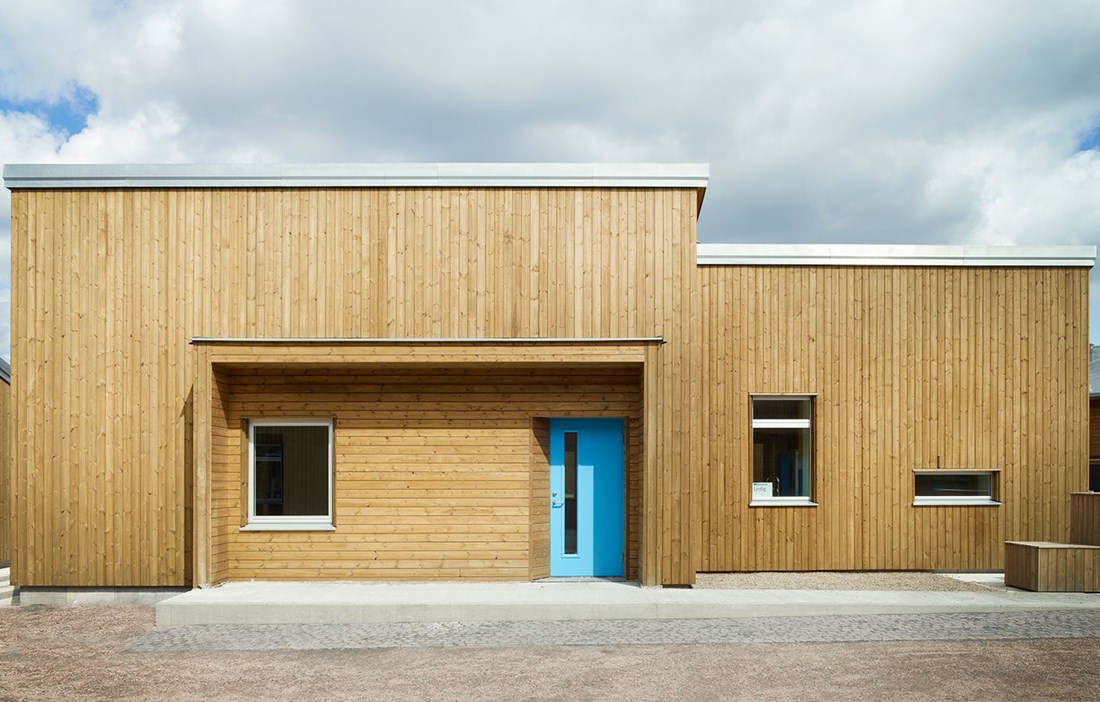

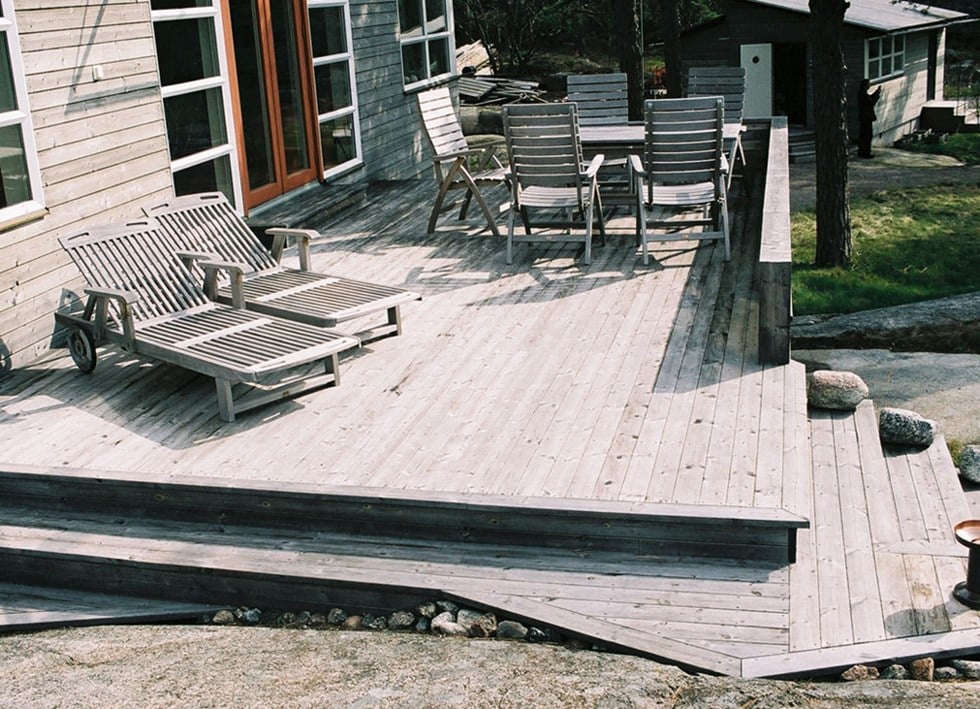
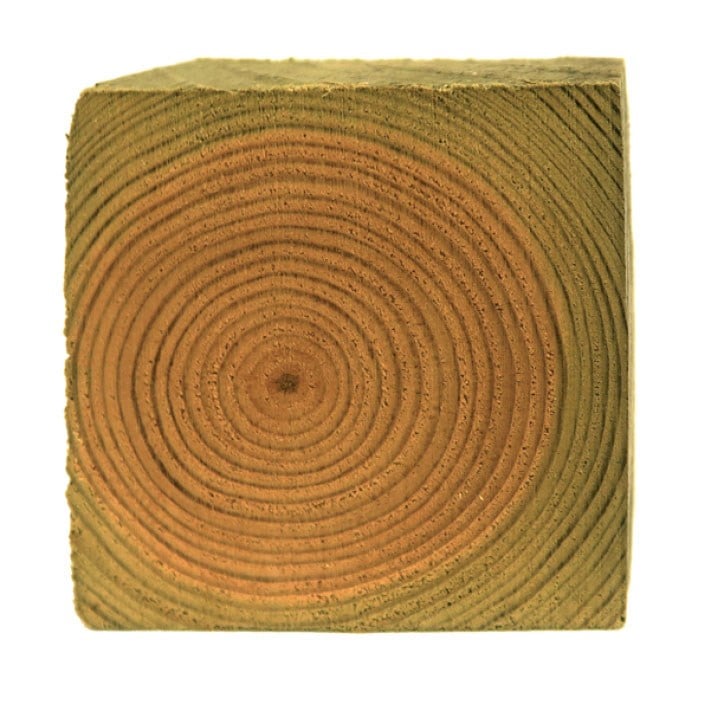
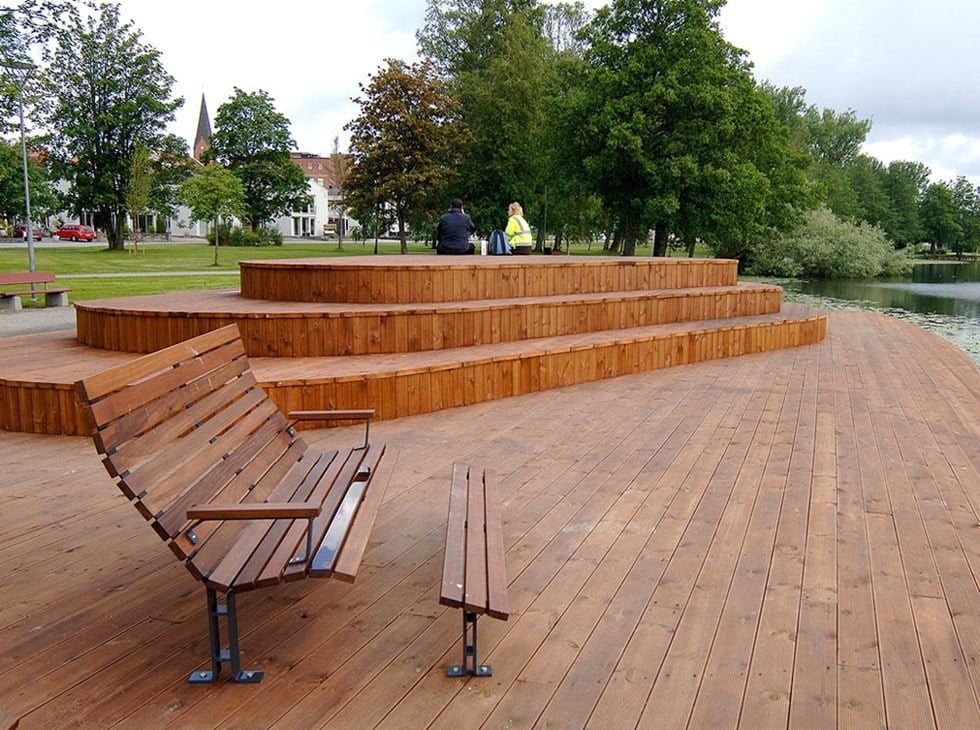
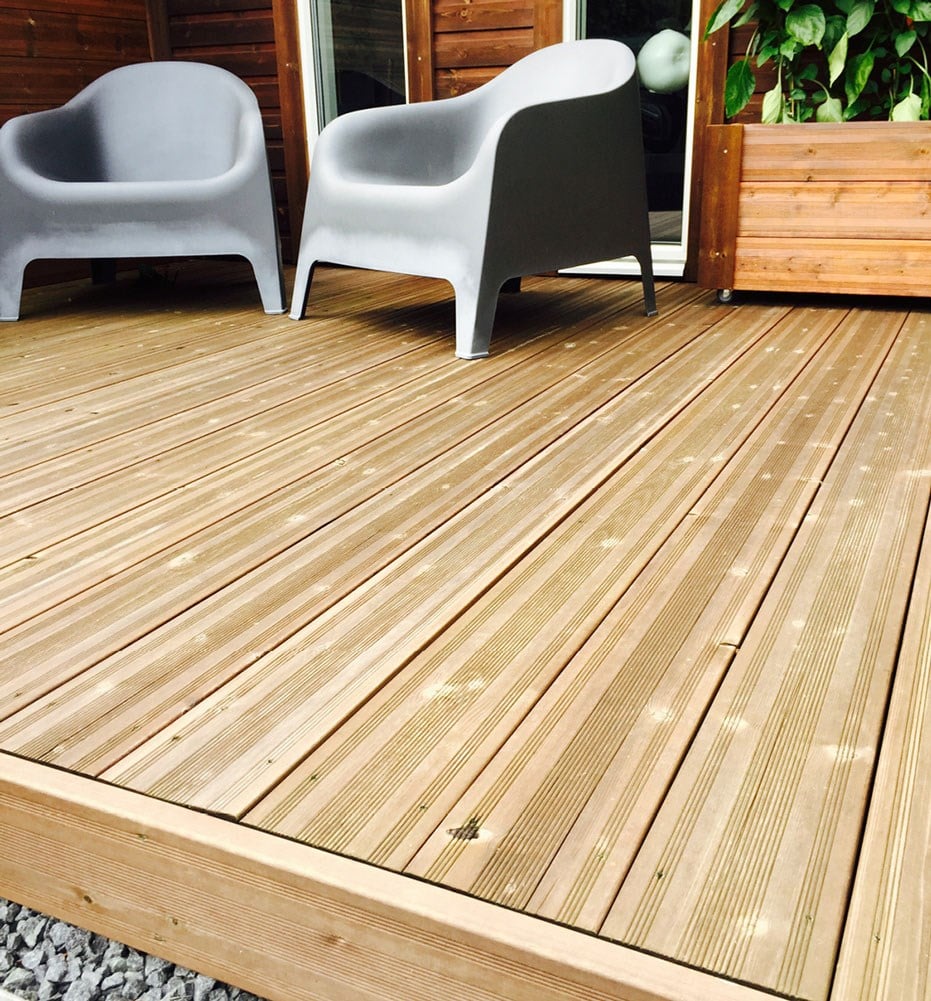
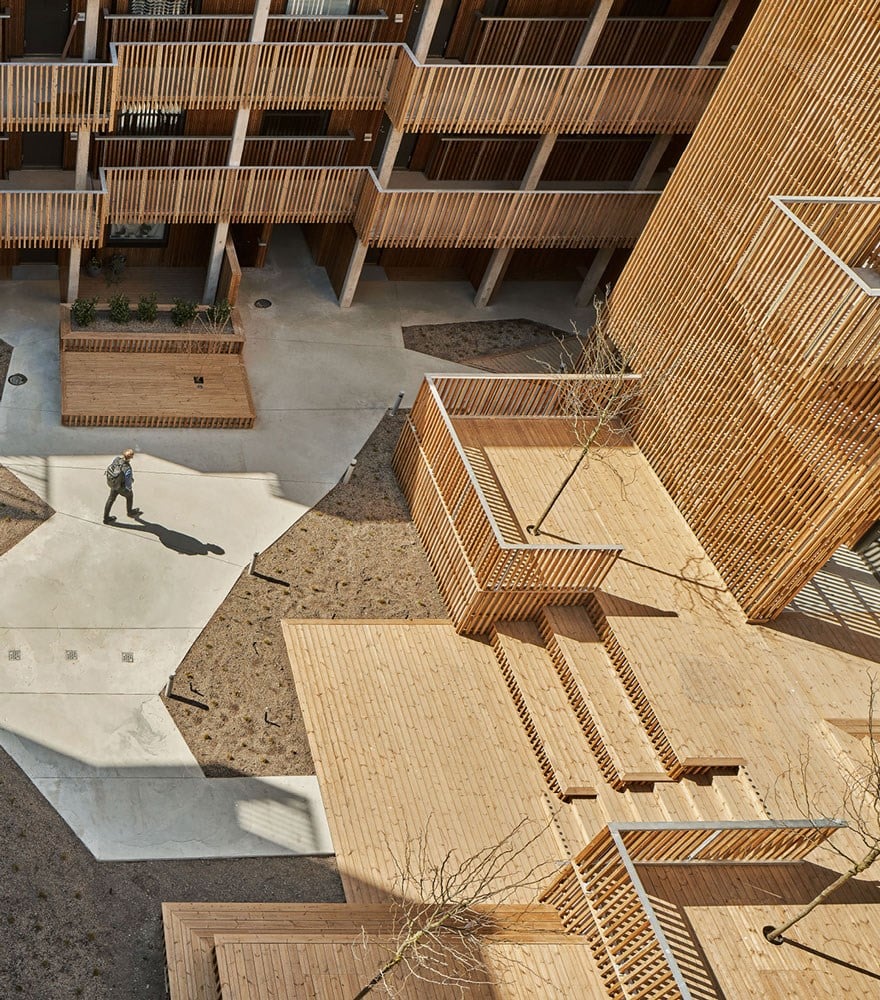
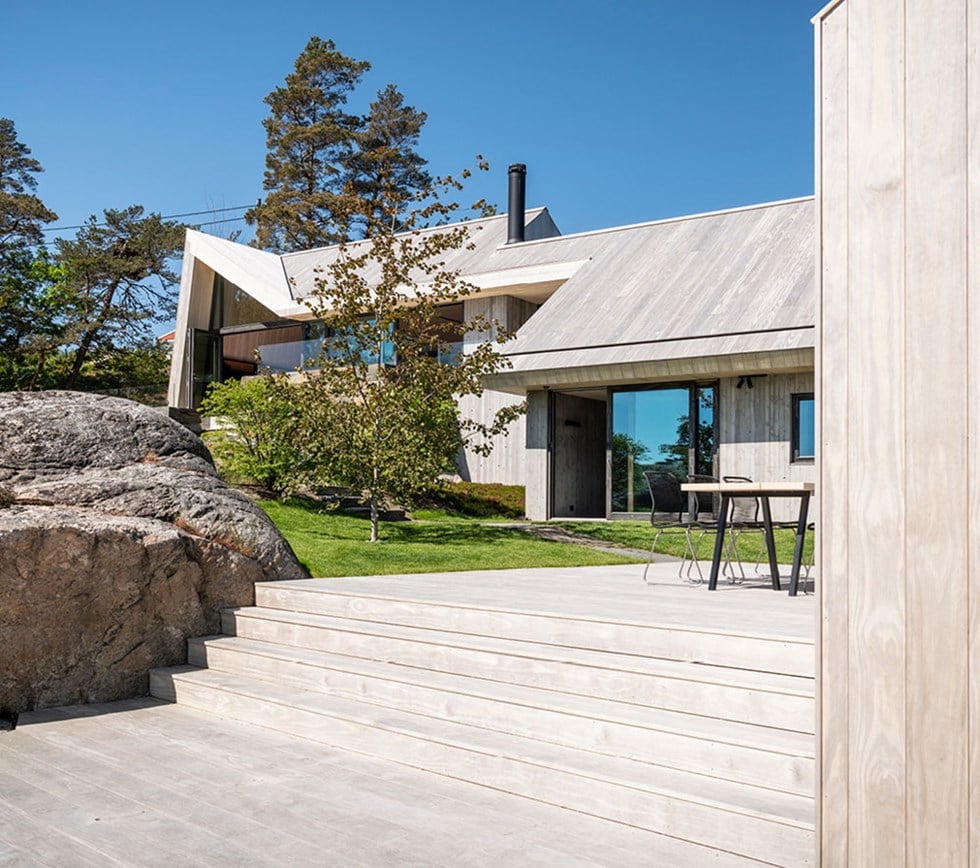
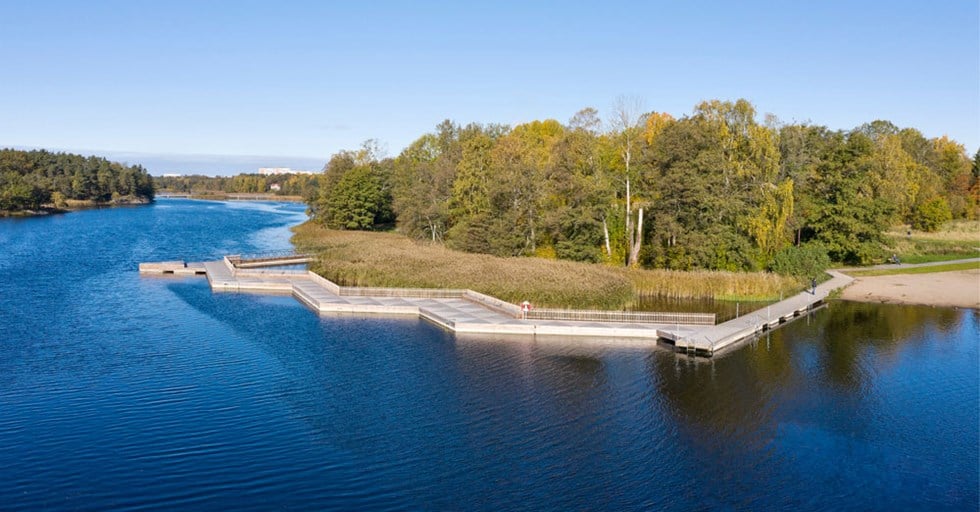
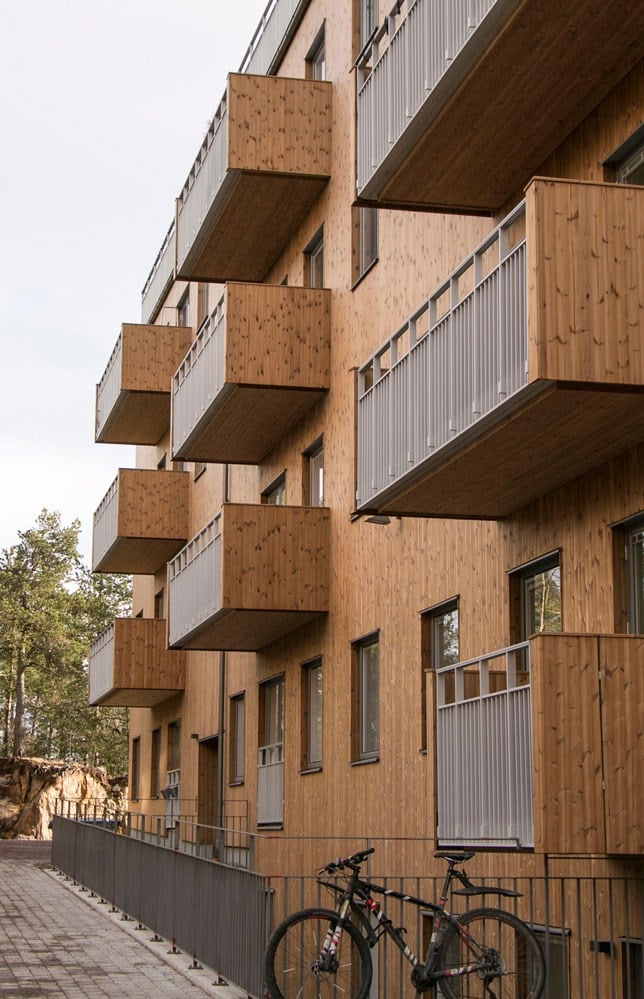 Fireproofed cladding. Kv. Taklampan, Hammarbyhöjden, Stockholm.
Fireproofed cladding. Kv. Taklampan, Hammarbyhöjden, Stockholm.
